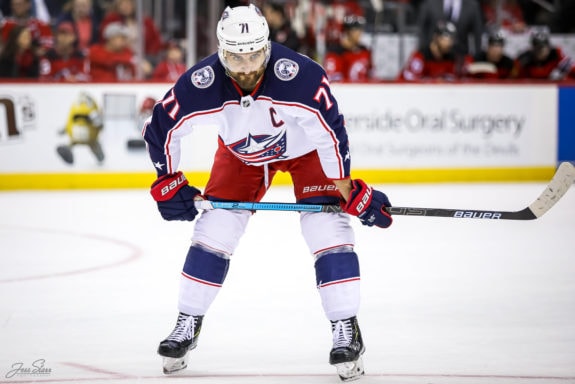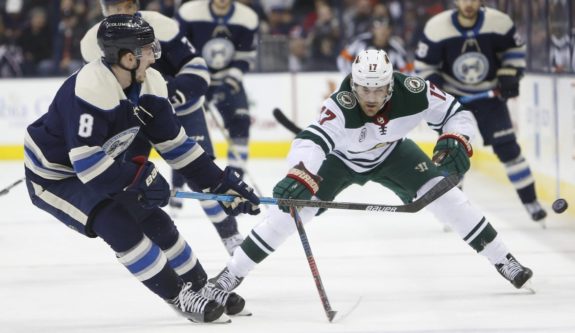
 Emily Dattilo
The Hockey Writers
Emily Dattilo
The Hockey Writers
159
Reads
0
Comments
The “Foligno Leap”: Understanding this Goal-Celebration Legacy
A buzzer blares. Half the crowd cheers and screams, while the other half sits shaking their heads, disappointed. For a brief moment, precision and poise on the ice melt away as the players form a huddle of congratulations.
Goal.
A goal signifies a culmination of teamwork, skill and a glint of open net. For Mike Foligno, who played in the NHL for 15 seasons, a goal also meant an exuberant celebration. During his NHL career, he played for the Detroit Red Wings, Buffalo Sabres, Toronto Maple Leafs, and Florida Panthers.
Related: Brothers in the NHL
Termed the “Foligno leap,” after a goal, Mike would skate away in a streak of excitement, arms spinning, both feet leaving the ground — a display of pure joy. Playing in 1018 NHL games, he created a legacy and one that both of his sons have followed.
In a YouTube video from 2007, Mike’s son, 19-year-old Nick Foligno chatted about the importance of hard work and dedication on the ice, in regards to the Foligno leap.
“If you want to celebrate like an NHL player, you have to put in the time,” he said.
It took Nick a while to figure out whether he wanted to create his own signature reaction or follow in his father’s footsteps, but ultimately, he debuted the leap after his first NHL goal in 2007. For his brother Marcus, that old family tradition resurfaced while playing for the Sabres in 2012.
Related: Redoing the 2005 NHL Draft
Nick Foligno, now 32 years old, is the captain of the Columbus Blue Jackets, and his younger brother Marcus plays for the Minnesota Wild. Family roots are important to the Folignos and in June 2017, Nick tweeted his support for Marcus before he joined the Wild.
The hashtag “Mooseontheloose” refers to Marcus’s childhood nickname — chosen when he started getting bigger than his older brother.
Growing up Foligno
Like most brothers, Nick and Marcus spent a lot of time together, and in a video posted by the Sabres in 2013, the pair sat down to chat about hockey and family life.
Between the two, Marcus is more of a free spirit, whereas Nick acts like the classic older brother — organized, meticulous and calm. The brothers shared a room as kids, and in the video, Marcus bugged Nick about his need to put everything away after practice (often very loudly), whereas Marcus would toss his stuff on the ground and go straight to bed. The brothers talked about growing up with Mike as a father and reminisced about the special opportunities they had.
“At a young age, you don’t realize until you get older and realize how fortunate you were,” Nick said in the Sabres video. “You don’t realize it because to you, it’s just normal, it’s your dad, this is what he does.”

Sitting next to each other, it’s easy to spot the brothers’ resemblance — the quiet smiles, the facial expressions, even the style of talking. The tinge of competition doesn’t seem to disappear when the two find themselves outside the rink, yet it’s a friendly rivalry.
Family comes before anything that happens on the ice. When Marcus was drafted, their mother Janis was fighting breast cancer, yet it didn’t stop her from supporting her son.

“I thought the timing of it all too, just it’s like she held on for that much longer just to see where you would end up and knowing that, you know, you’re going to be all right,” Marcus said in the video.
After their mother passed away in 2009, the family created The Janis Foligno Foundation in her memory to help find a cure.
Today, Mike is a scout for the Vegas Golden Knights, but during his professional career, he wore the number 17. Now, carrying on the legacy with a twist — a Foligno leap thrown in here and there — Nick wears number 77 and Marcus wears number 17.
The post The “Foligno Leap”: Understanding this Goal-Celebration Legacy appeared first on The Hockey Writers.
Popular Articles

















































 Blackhawks Chicago
Blackhawks Chicago Panthers Florida
Panthers Florida Penguins Pittsburgh
Penguins Pittsburgh Rangers New York
Rangers New York Avalanche Colorado
Avalanche Colorado Kings Los Angeles
Kings Los Angeles Maple Leafs Toronto
Maple Leafs Toronto Bruins Boston
Bruins Boston Capitals Washington
Capitals Washington Flames Calgary
Flames Calgary Oilers Edmonton
Oilers Edmonton Golden Knights Vegas
Golden Knights Vegas Islanders New York
Islanders New York Sabres Buffalo
Sabres Buffalo Red Wings Detroit
Red Wings Detroit Senators Ottawa
Senators Ottawa Lightning Tampa Bay
Lightning Tampa Bay Flyers Philadelphia
Flyers Philadelphia Devils New Jersey
Devils New Jersey Hurricanes Carolina
Hurricanes Carolina Blue Jackets Columbus
Blue Jackets Columbus Predators Nashville
Predators Nashville Wild Minnesota
Wild Minnesota Blues St. Louis
Blues St. Louis Stars Dallas
Stars Dallas Jets Winnipeg
Jets Winnipeg Mammoth Utah
Mammoth Utah Sharks San Jose
Sharks San Jose Canucks Vancouver
Canucks Vancouver Ducks Anaheim
Ducks Anaheim






